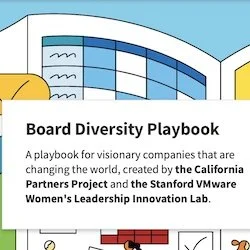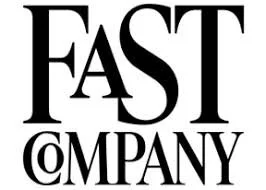How to Build an Inclusive Board Culture that Reaps the Value of Diversity
While changing the culture of the way a board operates may sound daunting, seemingly small wins can go a long way to making boards more inclusive
How DEI Can Survive This Era of Backlash
Despite recent backlash against and cuts to organizational DEI initiatives, researchers from the Stanford VMware Women’s Leadership Innovation Lab argue that DEI isn’t dead in the U.S.
Diligent Elevate Conference Day 1 Highlights
Read about how Lori’s session contributed to attendees understanding of how to build powerful relationships on boards by embracing differences
Accelerating Board Diversity and Inclusion
This podcast episode explores the strategic partnership between the Lab and the California Partners Project and digs into key takeaways from their recent playbook on board inclusion.
Inclusive Insights: Cultivating Change in the Boardroom
A podcast with Lori Nishiura Mackenzie, co-founder of the Stanford VMware Women’s Leadership Innovation Lab and faculty member of Leading Women Executives; and Deb DeHaas, CEO, Corporate Leadership Center.
Seven Ways To Improve Your Negotiation Skills
Lori weighs in on negotiation skills vs. the Gender Gap
KQED Forum on Performance Reviews
Lori is interviewed for her thoughts on the latest research regarding how companies conduct performance reviews
Interview on Board Culture Playbook
Speaking about the Board Culture Playbook at the Womentech Global Conference April 23-25, 2025.
Introducing the Board Culture Playbook
This resource was developed by the Stanford VMware Women’s Leadership Innovation Lab and the California Partners Project, with an aim to empower change agents with research-based approaches to improve the culture their boards.
Board Diversity Playbook
This resource was developed by the Stanford VMware Women’s Leadership Innovation Lab and the California Partners Project, with an aim to empower change agents with research-based approaches to advance diverse women’s leadership. We bring together leading experts and people in the field to capture the best ideas for those seeking to diversify their boards.
Institutional Courage in Action: Racism, Sexual Violence, & Concrete Institutional Change
Hosted and co-sponsored by the Center for Advanced Study in the Behavioral Sciences (CASBS) at Stanford University in the U.S., the 2022 Center for Institutional Courage: Racism, Sexual Violence, and Institutional Courage Workshop (The Workshop) was held on 18 March 2022.
The Myths and Rituals of Inclusion
Lori Nishiura Mackenzie, Lead Strategist of Diversity, Equity & Inclusion at the Stanford Graduate School of Business, speaks on the common beliefs on what work is, how it shapes our behaviors, and how these work myths can lead to deterring inclusivity in workplaces.
How to remove "doubt" when writing about performance
Language is powerful. It can convey confidence. Or doubt. Words that convey dilute your advocacy are often hidden from view. I wrote this article to help you do a "doubt check" and remove the diluting words, so that you can have more impact when writing introductions, performance evaluations, bios, and any description of performance or achievements.
Rooney Rule Regression: Takeaways for Corporate Board Diversity
The NFL’s Rooney Rule, requiring that at least one person of color be interviewed for head coaching vacancies, has lost its effectiveness in the NFL but should still be used by corporate boards to improve diversity.
Using a Mantra to Be a More Inclusive Leader
Cohesive teams are critical for organizational success, innovation, and fostering a sense of belonging. Yet one of the greatest challenges facing leaders today is creating a culture of inclusiveness, where all members are treated equitably and feel equally valued.
Reimagining Inclusion At Your Organization
Live event in Hopin restreamed to YouTube discussing Inclusion
The Language of Leadership
The words we use to describe others in the workplace, particularly when it comes to evaluating performance, need to be chosen with care. Often, we use different words when describing men and women, which can have a profound impact on perceptions, decisions and opportunities.
Hitting reset: 5 ways the pandemic could benefit working moms in the long term
Corporate America has a chance to rethink how it operates. What if businesses ultimately respond to this moment by creating more supportive office cultures?
Want to Promote Allyship in Your Company? Crowdsource It
The best way to include everyone is to involve everyone.
Asian American Pacific Islander (AAPI) heritage month arrived this year amidst great heartache from AAPI violence and the great achievement of Chloe Zhao's breakthrough Oscar win. The events invite a different response, one that acknowledges history, achievements, and heartaches. We must rethink how we honor the deep, rich, and complex contributions of the AAPI community during this heritage month to break through myths and engage in allyship.
How to Be a Principled and Purposeful CEO
CEOs are our most trusted leaders. They must lead on political, social and health concerns while still delivering profit
How to Lead Your Company as a True Ally
To bring real change to your company, start by educating yourself
Are Your Diversity Efforts Othering Underrepresented Groups?
In pursuit of living up to anti-racist pledges, many companies have prioritized hiring “diverse” talent to increase representation of Black employees. But this “quick fix” for racial equity doesn’t actually create an environment that’s actually inclusive of people of color. Language is one part of the problem.
Context Matters: Moving beyond “Best Practices” to Creating Sustainable Change
Enhancing diversity and inclusion are priorities for many organizations, yet leaders often lack a clear direction as to how to create the desired change. The aim of the Stanford VMware Women’s Leadership Innovation Lab is to combine academic and real world insights to develop strategies that will help organizations make their workplaces more diverse and inclusive.
How Do You Evaluate Performance During a Pandemic?
The ongoing crises of 2020 are affecting women’s careers and, as we enter performance review season, managers have a responsibility to make sure that bias against women — and women of color in particular — doesn’t do further damage. If you want to retain this critical group of talent and avoid lasting consequences for workplace diversity, it will help to rethink how your organization handles performance reviews.
The Cost of Fitting In
The emphasis on strong, homogenous company cultures can erase the diversity organizations should be striving for, say these 3 Stanford experts on inclusion. Here are 5 ways to find the right balance.
3 Things Managers Can Do to Confront Microaggressions Head On
Your goal isn’t to automatically have all the answers — it’s to surface topics in your blind spots and learn more about them.
Diversity and Inclusion Efforts That Really Work
In the wake of major social and political changes over the past decades, leading companies are taking steps to increase diversity, equity, and inclusion. Yet progress in most sectors remains tepid. Programs designed to increase diversity and inclusion in the workplace often fail. So that leads to a natural question: What’s actually working?
Small Wins Quarterback: A Winning Strategy
Go big or go home. Be Bold. Shoot for the stars. In U.S. culture, we are surrounded by the notion that bigger is better and that the only way to be successful is to think BIG. In leadership narratives, this translates into advice to “Disrupt. Scale at all costs. Blow it up.” In other words, throw out the playbook.
How stereotypes become embedded in our views
Researchers from the Stanford Graduate School of Business explain how we learn bias from an early age.
Digging Deeper into Stanford GSB’s 2019 Diversity, Equity & Inclusion Report
In this podcast episode, you’ll hear directly from Sarah A. Soule, the Senior Associate Dean in charge of DEI, and Lori Nishiura Mackenzie, the Lead Strategist for DEI, as they walk us through the DEI report for the Stanford Graduate School of Business. They will discuss DEI progress at Stanford GSB, what it all means for MBA applicants and students, and more.
If Women Don’t Apply to Your Company, This Is Probably Why
At the Stanford VMware Women’s Leadership Lab, where we work with leading companies to help them attract, retain, and advance a diverse pool of talent, we hear comments like these quite a bit. And every time we are reminded of the art of fishing: If you don’t catch a fish, you don’t blame the fish. You change your technique.
Diverse Insights: A Conversation with Lori Nishiura Mackenzie
#DiverseInsights - a series of conversations with the trailblazers turning diversity, inclusion and belonging ambition into action. Our fourth conversation is with Lori Nishiura Mackenzie.
FOTOG/GETTY IMAGES
The Stereotypes in MBA Case Studies
Stereotypes are often reinforced by the words we choose to use. For example, when researchers recently analyzed massive text datasets, they found that in the 1910s, Asians in the U.S. were often characterized by words like “barbaric” or “monstrous” while descriptors like “passive” and “sensitive” are more common today.
The Language of Leadership Podcast
Often the language people use to communicate impacts how others relate and perceive. In this podcast, Lori discusses research-based insights of how you can overcome areas where unconscious bias is playing a role.
SVTAGS: Silicon Valley -Technology, Art, Green and Sustainability: Interview
Interview on local TV show about Lori’s career and describing the work at the Stanford VMware Women’s Leadership Innovation Lab
Podcast: Debugging Meritocracy
In her interview, Lori touches on the Paradox of Meritocracy, which is how we as individual managers opened the doors to be more biased. The Paradox of Meritocracy has created the conversation about how to debug meritocracy and the way that bias will make the performance of men look better for the same level of performance, disadvantaging women and people of color.
DANIEL GRILL/GETTY IMAGES
Why Most Performance Evaluations Are Biased, and How to Fix Them
For many companies, performance review season is kicking off with the new year. Although every organization relies on a different evaluation process, most follow a predictable pattern: First, they invite employees to write about their accomplishments and what they need to improve. Then managers write assessments of their work, offer feedback, and rate their performance on a scale of how well they met expectations.
The New Law Requiring More Women on Corporate Boards: Thumb Up or Thumb Down?
Since Senate Bill 826 recently became law, a lot has been said about the new mandate that companies headquartered in California must include one to three women on their board of directors, depending on their board size: It’s good for women. It’ll ultimately hurt women. It’ll never withstand legal challenge. It doesn’t go far enough. . .
Women Leaders are not Unicorns
Dear Corporate Board Search Committees:
Women leaders are not unicorns. Especially women highly-qualified for corporate board oversight. You will find them — if you change up the conventional search process.
A new law makes California the first state to require corporate boards of directors to include women. That means nearly 100 companies will have to add a woman to their boards—some, more than one.
Two Powerful Ways Managers Can Curb Implicit Biases
The problem is that, when hiring, evaluating, or promoting employees, we often measure people against our implicit assumptions of what talent looks like — our hidden “template of success.” These templates potentially favor one group over others, even if members of each group were equally likely to be successful.Our research shows that there are two, small — but powerful — ways managers can block bias: First, by closely examining and broadening their definitions of success, and second, by asking what each person adds to their teams, what we call their “additive contribution.”
How do you debunk the "Safe Bet" narrative in hiring?
In some recent talks about inclusive hiring, I couldn’t help but wonder why there was so much conversation about the “safe bet.” What is the safe bet? A “safe bet,” according to the online dictionary, is a thing in which confidence can be placed regarding a future outcome. Around hiring, the “safe bet” is a term often used to describe the “traditional candidate.”
The phrase "lacks executive presence" is holding back women leaders
“Executive Presence” is often defined as commanding a room, having gravitas or communicating decisively. This critical leadership characteristic is rarely based on demonstrated behaviors, but instead on whether others perceiveyou as having it. And who has it can be limited by stereotypes. My solution? Ban "lacks executive presence" from your lexicon of feedback to offer women.
Dollars and Change Podcast
Dollars and Change celebrates the contributions of Wharton alumni on our annual Wharton Business Radio "Reunion Radio" special. Meet Lori Nishiura Mackenzie (WG'93), Executive Director of Stanford University's Clayman Institute for Gender Research and Co-Founder of the Stanford Center for Women’s Leadership, who is making a difference in her industry - hosts Sherryl Kuhlman and Nick Ashburn find out more about her latest initiatives.
To Succeed in Tech, Women Need More Visibility
When asked about the most critical factors for promotion to their level, leaders are prone to say “visibility.” Visibility is a complex interaction of perceived skills (particularly technical and leadership ones), access to stretch assignments, and being known — and liked — by influential senior leaders within informal networks. All three are necessary for advancement.
The Chopping Block Paradox: Why Companies Cut Programs They Can’t Afford to Lose
The CEOs of Best Buy, Yahoo!, and Hewlett Packard all nixed flexible work policies in response to financial downturns. “During this critical turnaround period, HP needs all hands on deck,” said Hewlett-Packard CEO Meg Whitman. “[T]he more employees we get into the office, the better company we will be.”
What Dads Really Want This Father’s Day
Those first years of motherhood were rough.
After years of being a result-oriented MBA professional, I struggled like most new moms with the lack of sleep and seemingly ceaseless crying from my colicky newborn. My husband was getting his evening MBA at the time, attending many evening and weekend study groups, meaning that much of the time, I was parenting on my own.








































